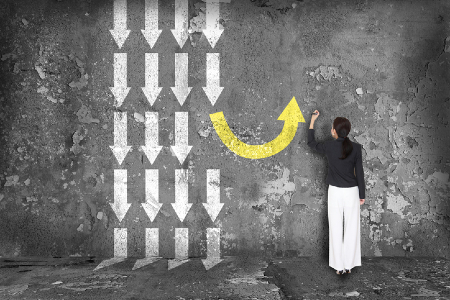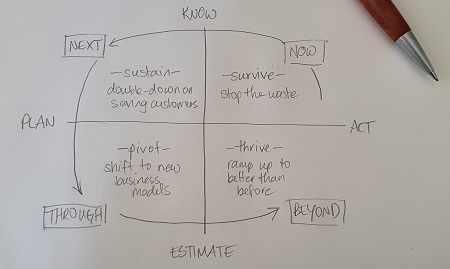How to Find the Right KPIs to Pivot Performance Through a Crisis
by Stacey Barr |Here is a framework for how to measure through any crisis, to help us pivot and be ready for – or even create – a new normal.

According to the ABS, about 70 percent of Australian businesses have had to change the way they operate, as a direct result of the COVID-19 crisis. The same proportion also had a decrease in revenue. The story across the rest of the world would be similar. Not one of us has witnessed crisis quite on this scale before.
Consequently, we’re all trying to figure out how to navigate our way through and out of it. I don’t profess to have the answer. I thought, however, it might be useful if I shared my current thoughts, as a starting point. It’s a starting point for how we can navigate through and beyond a crisis, using the right measures to focus us on the stages of the journey.
Your reactions and contributions are welcome in the comments.
The ideal journey through a crisis is to survive, so we can thrive again.
The role that measurement plays on the journey through a crisis is to narrow our focus on only those things that matter to the stage we’re at through that crisis. In my mind, at least, finding this focus means balancing acting with planning, and knowing with estimating.
Here’s the model I sketched out:

Along this journey through a crisis, we need to shift the bias between planning and acting. Sometimes we need our head in the clouds, for a longer view. Other times we need our feet on the ground, to get stuff done.
And we need to shift the bias between what we know and what we can only estimate. Sometimes we need to rely on existing measures, to make decisions on fact. Other times we need to find new measures, to make decisions about the future.
These dimensions give us a pathway or roadmap to move through the four stages of a business’s journey through a crisis, just like COVID-19:
Now: when the crisis hits, we need to stop the biggest sources of waste.
One of the hallmarks of crisis in business is a loss of revenue. Suddenly, there isn’t the cash flow or income to pay the usual bills.
Now, we need to act quickly on what we know, and often that’s finding and reducing or eliminating sources of wasteful spending. To help us, we’d track existing measures that quantify this waste.
Other important existing measures to be ready to act on include safety, employee well-being, and cash flow.
In the early stages of the COVID-19 crisis, I focused on Operating Costs, and reduced it by cancelling apps I could live without, switching to alternative apps that were cheaper (and as it turned out, better), and getting my team to put a hold on activities that no longer were urgent.
Next: when the crisis sets in, we need to double-down on serving existing customers.
As soon as our heads stop spinning, and we’re getting the waste under control, the next most urgent thing is keeping our existing customers.
Next, we need a bit of planning for how to continue serving them, within the constraints of the crisis. To help us, we’d focus on existing customer measures relating to our outreach, relationship management, customer support and current delivery promises.
Two measures I focused on were Website Visitors and Ezine Open Rate, as feedback about whether the new topics I was writing about were relevant and helpful in the context of COVID-19.
Through: while the crisis unfolds, we start to shift to new business models.
The third stage of the journey through a crisis is the time to start shifting and changing and responding to the new environment we’re going to be in for the next while, and possibly beyond it.
Through the crisis, it’s time to plan how our business should operate in the new normal. To help us, we can run a few new business experiments, and set up new measures to track their success.
One of my business experiments during COVID-19 was to run an online training and implementation-focused program (PuMP Online Immersion) for our clients whose workshops had to be cancelled. I’m tracking this new delivery mode with a few measures of online engagement, and also the PuMP Pilot implementation rate for our participants. Profit wasn’t the focus (and it
wasn’t the result either) because this experiment was more about testing a new way to continue serving our existing customers as best we could through COVID-19. But it can be profitable in the future, and still a very generous value-for-money for clients.
Beyond: in the wake of the crisis, we ramp up to be better than before.
The final stage of journeying through a crisis is when we ramp up what now can work well, and thrive from the refresh the crisis afforded us.
Beyond the crisis, we don’t want to lose what we learned, about reducing waste, engaging more deeply with our customers, and testing better ways of working and delivering. It’s still early days, but now we can get back to action, and make our forecasts of future performance become the new reality.
One of the predictions of the world beyond COVID-19 is more remote working. With the exceptional engagement we’re getting from our PuMP Online Immersion participants, I’m confident that more online delivery will work better for everyone (planet included). I’ll continue measuring the success of our new online program, and use the data we’ve gathered to make it a profitable program in the future.
What have you learned about pivoting your organisation through crisis?
Like I mentioned earlier, these are just my initial thoughts and personal experience in pivoting my business in response to a crisis like COVID-19.
But what have you learned?
KPIs can support the journey through a crisis by aligning to the important results for surviving first, then sustaining, pivoting, and thriving into the new normal.
[tweet this]
Connect with Stacey
Haven’t found what you’re looking for? Want more information? Fill out the form below and I’ll get in touch with you as soon as possible.
167 Eagle Street,
Brisbane Qld 4000,
Australia
ACN: 129953635
Director: Stacey Barr




